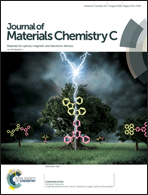Environment-friendly, durable, electro-conductive, and highly transparent heaters based on silver nanowire functionalized keratin nanofiber textiles†
Abstract
We demonstrate the fabrication of highly transparent, electro-conductive, durable, and eco-friendly nanofiber (NF) textiles based on keratin using highly conductive silver nanowire (Ag NW) networks on transparent nano-fibrous substrates for multifunctional, high-performance flexible heaters. These NF-based textiles, including keratin, have a high transparency of more than 89% in the visible area, making them very useful for manufacturing transparent wearable electronics. The Ag NW networks on the nanofibers provide a low sheet resistance of 25 Ω sq−1, with a maximum optical transparency of 85% and superior flexibility with mechanical durability up to 1000 cycles of bending and release. Flexible and transparent wearable electronic devices, such as heaters, with an exceptionally high mechanical stability and foldability with negligible changes in electrical conductivity have been successfully fabricated by using this simple method. Also, transparent conductive NFs based on keratin are a promising wearable electronic material for a wide range of high performance, low cost, biocompatible and wearable electronics applications. This study successfully demonstrates a flexible heater based on transparent conductive NFs with a wide operating temperature up to 65.75 °C, a good recovery time of about 10 s and low power consumption (0.38 W) for wearable electronics applications.



 Please wait while we load your content...
Please wait while we load your content...